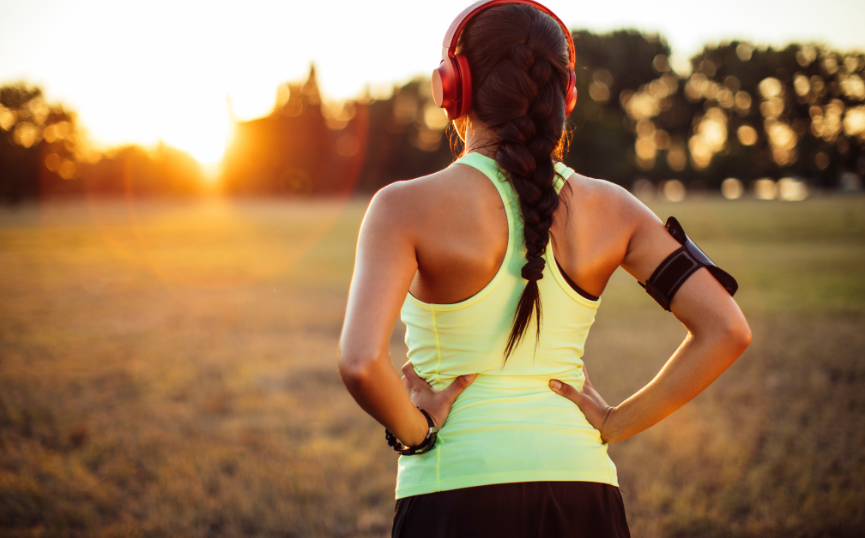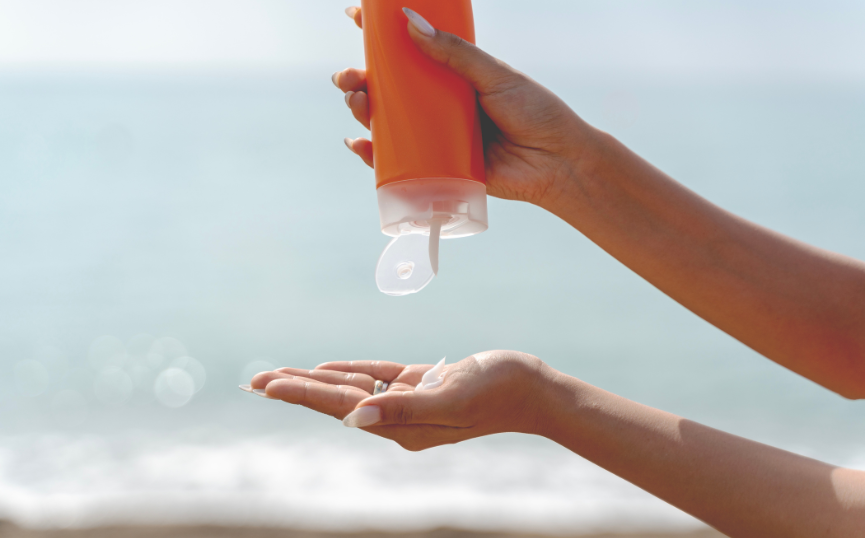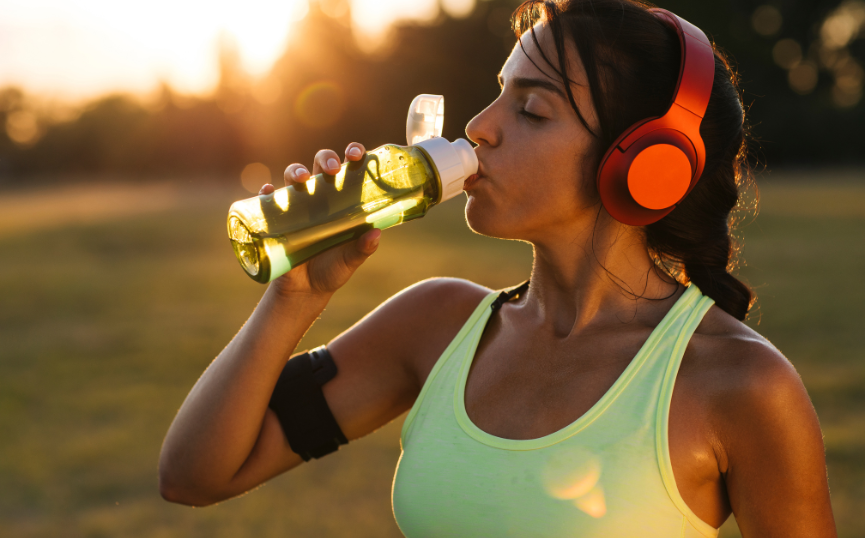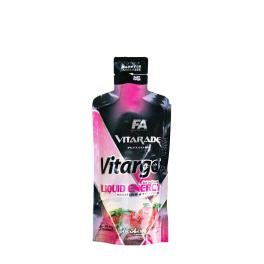6 tips – How to do sport in the heat
Here are some summer training tips to prevent heat stroke. We’ll show you cooling techniques for your workout and give you some practical knowledge about hydratation. Plus we reveal what’s proper hydratation during exercise?

In my twenty-nine years on Earth, I have learned one thing for sure. The Hungarian man is never satisfied with the weather. If it’s cold, it’s bad, if it’s hot, it’s bad! Of course the dangers of hot, muggy weather should not be underestimated, but as sportsmen and sportswomen, we don’t need to be discouraged by the heat! Here are our top tips to make exercising in the heat more enjoyable. Whether you’re running, cycling, hiking, hitting the gym or working out in the gym. Exercising outdoors and indoors can be tough in the summer heat. In fact, it may be even worse between the four walls. The more people you squeeze into the smaller space, the ’less and more stuffy the air’. High humidity can make exercise much more difficult for those sensitive to it.
1. DON’T DO SPORTS IN HOT SUN!
UV radiation is usually strongest around noon and there is a 5.5-hour peak period between 9:00 and 15:00.1 Avoid outdoor sports during this period. The harmful effects of UV are strongest between 11:00 and 15:00. Experts warn againts spending time in the sun between 11:00 and 15:00. As well as sunstroke, your skin can also be more damaged. Sunscreen is a must, but before we go into that, let’s look at what can cause sunstroke?
Sunstroke occurs when you are in the sun for a long period of time. Heating up the body can cause whole body effects (changes in blood circulation and increased heart rate, and when you can’t even sweat off the heat, your body overheats). Of all these, the direct inpact on the head is the most dangerous, as the temperature of the head can be much higher than that of the body. If this heated state persists for too long, the brain also overheats, resulting in increased intracranial pressure and excitation of the meninges. In short, head stroke develops.
Sunstroke can occur in healthy people, but there are diseases and medicines that predispose to it4-6:
- Cardiovascular diseases (such as high blood pressure, atherosclerosis and diabetes).
- Kidney diseases
- Chronic lung diseases (such as chronic obstructive pulmonary disease)
- Neurological and psychiatric disorders (such as Parkinson’s, Alzheimer’s, schizophrenia and bipolar disorders).
- Taking medicines (antipsychotics, diuretics, antihistamines, beta blockers and antidepressants)
- Obesity
- Old age
- Alcohol consumption and dehydratation
Therefore, if any of the above conditions or diseases apply, stay out of the sun between 11:00 and 15:00.
Obesity and age also increase the risk of sunstroke and heat stroke. If you are older and significantly overweight, do not stay out of the sun between 11:00 and 15:00.
And alcohol consumption causes extreme dehydratation, so avoid drinking alcohol in the 24 hour before exercise.
2. PREVENTION OF SUNSTROKE AND HEAT STROKE
Vitamin360’s cooling techniques for exercise:
- Never stay in the hot sun with your head uncovered! A hat or scarf is a must for everyone (even if you don’t exercise) and the lighter the better!
- Ladies: soak your bras in cold water, as well as your hats or headscarves. Alternatively, throw ice in the bra (to avoid cold burns, place it so that the ice is not in direct contact with the skin at first).
- Gentlemen: dip your hats or headscarves in cold water. Alternatively, throw ice down your trousers (to avoid cold burns, place between your underpants and running shorts).
- No alcohol for 24 hours before exercise! By the way: you are sportsmen!
- You need to hydrate well during exercise: in direct proportion to the length of your activity and the amount of water you sweat out. How to hydrate well is shown in the next chapter.
- Let’s not overdress. And apply sunscreen to the uncovered area 20-30 minutes before exercise.
- Always take a cold shower after exercise (gradually turning the tap towards blue, of course, to allow your body to adjust). Take a shower with maximally cold water for at least 5 minutes to allow your body to cool down.
Other non-sport advices and cooling techniques:
- Infants and young children should never be exposed to direct sunlight. They should be offered water frequently.
- The car can become extremely hot due to the green house effect, so never leave children or pets locked in the car, even for short periods.
- Driving in the heat increases the risk of accidents, so make sure the car is shaded and well ventilated before you set off.
- Sun protection is repeated every three hours during the day.
Advice for water sports:
- Suncreen is important here too! With the rules just outlined! In other words, apply 20-30 minutes before going out doors, then reapply every three hours.
- You don’t jump into the water with a hot body. Adapt first, then jump in.

3. THE SECRETS OF GOOD HYDRATATION
We can adapt to many things, but not to chronic dehydratation. So the water you’ve lost needs to be replenished! Okay. Okay. We haven't said anything new with this, but did you know that during exercise, maximum sweating can range from 1.5 litres to 3 litres per hour! As an example, marathon runner Alberto Salazar sweated 3.71 litres per hour (the record) at the 1984 Olympics.
So you sweat more than you might think. Don't underestimate the importance of hydration!
Remember that hydratation starts before exercise7-9!
- 24 hours before training:
- Drink enough fluids to keep the colour of your urine light yellow. A dark urine colour may indicate dehydratation.
- 2-3 hours before your workout:
- Drink 500-600 ml (about 2-3 glasses) of water.
- 20-30 minutes before your workout:
- Drink an additional 200-300 ml (about 1 glass) of water.
- Don’t overdo the caffeine before training!
- In addition to the effect of caffeine on adrenaline, it keeps the heart pumping.
- And caffeine is dehydrating because of its diuretic effects.
- We’re not saying don’t use it, just be careful.
Hydratation during exercise7-9:
- Drink only water (100-200 ml every 15-20 minutes) during exercise lasting less than 60 minutes.
- For workloads over 60 minutes, energy gels should be consumed. These gels replace lost minerals (electrolytes) and sugars. *They provide energy that can be used quickly, but not water! Therefore, water should be drunk with the consumption of these gels (100-200 ml every 15-20 minutes).
- Repeat the consumption of energy gels every 45-60 minutes.
*Please note that the energy gel we recommend also contains caffeine. A sachet of 40 mg will keep you energised during exercise, but will not be suitable for those sensitive to caffeine.
Post-workout hydration
- Immediately after the workout:
- Drink 500-600 ml (about 2-3 glasses) of water.
- In the next few hours:
- Drink extra fluid to make up for the fluid lost during exercise. As a general rule, for every kilogram of body weight lost, about 1.5 litres of fluid should be replenished. You can check this by measuring your body weight before and after exercise. You’ll surprised how much water you can lose in one long workout!

4. BREATHING TECHNIQUES TO ADAPT TO THE HEAT
High temperatures and humidity increase the blood supply to the skin, which in turn causes the heart to beat faster.2,3 So the heat increases our heart rate, which in itself is a problem, because at the same time the work of the heart increases and the energy-absorbing processes change. The good news is that with the right breathing techniques we can slow down our heart rate.
To lower our heart rate, we need to stretch the length of the exhalation and increase its force. During cardio workouts, pay attention to the lengthening your exhales to optimise your performance in the heat.
5. DON’T FORGET TO LOOK AFTER YOUR SKIN!
It’s worth using lotions to stimulate the regeneration of skin damaged by UV radiation. There are a number of skin soothing oils, but you can broaden the spectrum of skin regenerating ingredients with Vitamin360’s original formula.
Take a 150 ml jar. Add 125 ml of Now Foods Liquid Coconut Oil or Now Foods Jojoba Oil and fill the rest with Now Foods Organic Argan Oil.
6. SUMMER WORKOUT TIPS
Even though all the information is given so far has been true for everyone who does sport in the heat.
But now we’ve got some tips specifically for cardio exercises. Endurance athletes can often make the mistake of not putting enough emphasis on strength training.
Strength training requires a change in breathing techniques, so this form of exercise works the muscles needed to breath differently.10 And muggy and hot weather also puts more strain on the respiratory system.11 So you’re also training your respiratory system with strength training, so you’ll be better able to cope with the respiratory stress caused by the heat.
Also, many people forget the importance of winter training, using an „elevation training mask” can create an oxygen deprived environment, which further increases the strength of the muscles needed to breathe.12 This allows users of such mask to stimulate high altitude-training. In the mountains, the air is also sparse.
We wish you good sport in this hellish heat!
- https://cancer-code-europe.iarc.fr/index.php/hu/12-mod/napozas-uv-terheles/4313-mikor-a-legerosebb-a-nap
- https://www.mayoclinichealthsystem.org/hometown-health/speaking-of-health/effects-of-high-temperatures-on-blood-pressure-heart
- Wilson TE, Crandall CG. Effect of thermal stress on cardiac function. Exerc Sport Sci Rev. 2011 Jan;39(1):12-7. doi: 10.1097/JES.0b013e318201eed6. PMID: 21088607; PMCID: PMC3076691.
- Patel, D. R., Gyamfi, R., & Torres, A. (2010). Exertional heat illness in adolescent athletes: A literature review and update. Journal of Clinical Research in Pediatric Endocrinology, 2(4), 161-167. PubMed
- Glazer, J. L. (2005). Management of heatstroke and heat exhaustion. American Family Physician, 71(11), 2133-2140. PubMed
- Bouchama, A., & Knochel, J. P. (2002). Heat stroke. New England Journal of Medicine, 346(25), 1978-1988. PubMed
- Sawka, M. N., Burke, L. M., Eichner, E. R., Maughan, R. J., Montain, S. J., & Stachenfeld, N. S. (2007). American College of Sports Medicine position stand. Exercise and fluid replacement. Medicine and Science in Sports and Exercise, 39(2), 377-390. PubMed
- Kenefick, R. W., & Cheuvront, S. N. (2012). Hydration for recreational sport and physical activity. Nutrition Reviews, 70(suppl_2), S137-S142. PubMed
- Casa, D. J., Armstrong, L. E., Hillman, S. K., Montain, S. J., Reiff, R. V., Rich, B. S., ... & Stone, J. A. (2000). National athletic trainers' association position statement: fluid replacement for athletes. Journal of Athletic Training, 35(2), 212-224. PubMed
- Kowalski, Tomasz MSc1; Granda, Dominika PhD2; Klusiewicz, Andrzej PhD3. Practical Application of Respiratory Muscle Training in Endurance Sports. Strength and Conditioning Journal ():10.1519/SSC.0000000000000842, April 2, 2024. | DOI: 10.1519/SSC.0000000000000842
- https://www.sciencedirect.com/science/article/abs/pii/S1569904814000974?via%3Dihub
- Porcari JP, Probst L, Forrester K, Doberstein S, Foster C, Cress ML, Schmidt K. Effect of Wearing the Elevation Training Mask on Aerobic Capacity, Lung Function, and Hematological Variables. J Sports Sci Med. 2016 May 23;15(2):379-86. PMID: 27274679; PMCID: PMC4879455.






